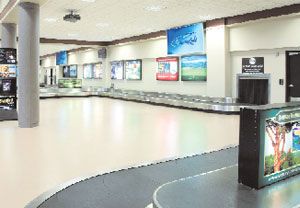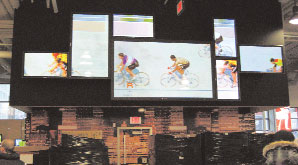The Digi Awards is the only industry award program that recognizes the outstanding integrators, content providers, and now product manufacturers focusing on digital signage. The Digi Awards are co-produced by digital signage magazine and the digital signage group. This year, there were 17 Digi Award categories, recognizing every vertical market from retail to civic spaces...and also new products.
- Judges for the 2008 DIGI Awards were:
- David Keene, executive editor of Digital Signage Magazine and DIGI
- Awards Chairman
- Alan Brawn, principal, Brawn Consulting
- Lyle Bunn, principal, Lyle Bunn Consulting
Retail/Local RolloutDigital Display & Communications
Future Shop flagship store, Toronto
Commissioned to create a
Digital Display & Communications for Future Shopspectacular, dynamic focal point for the new Dundas Square Future Shop flagship store in downtown Toronto, Digital Display & Communications designed and installed a unique, large-format digital signage system between Summer 2007 and November 2007. The system, a "feature wall" deployed in the heart of Canada's "Times Square," delivers a store-wide visual experience that helps position the brand as a technologically advanced, leading-edge consumer electronics retailer by using innovative visual imagery.
The design challenge was to propose a large format, unique display system that utilized flat panel display technology available for sale at Future Shop. It was for this reason that projection options were not considered. In the end, Panasonic plasma displays in both landscape & portrait format -- in sizes from 42" to 103" -- were selected to create a large scale video "collage" with image quality & consistency, plus mounting solutions. Once this design direction was taken, it was very challenging sourcing the technology that could scale & process video and still stay within accepted budget.
A software solution was favored over a standard hardware video processing solution, both because of budget as well as the greater flexibility a software solution could deliver. Using C-Nario software to remotely control all video scaling, management, distribution and monitoring from DDC's Network Operations Centre in Waterloo, Ontario, content plays back seamlessly despite the differing display resolutions & orientations. Selecting and testing a new software technology (C-Nario) within a very tight timeline was challenging. Fortunately, digital signage experience using various software platforms combined with excellent collaboration from the C-Nario team (based in Israel) helped ensure the successful implementation. Magenta CAT technology was used for the signal cabling.
Drawing on 10+ years designing, installing & managing digital signage systems, Digital Display & Communications was able to source required components & manage the project from initial design through to installation & ongoing management, including content services. DDC sourced & encoded all HD video used for the system. There is no advertising or promotional content on the display. The intent is to provide thrilling "eye candy" to enhance the customer experience. DDC was the single point of content for the customer, using "the full picture" approach, addressing all required success elements at the very beginning of the planning & system design phase.
The scale of this large installation -- together with some very powerful scaling & video processing capabilities -- is intended to dazzle the viewer and enhance their overall shopping experience. The success of this project is ultimately measured by the positive feedback of the customers, i.e., positive shopping experiences. There is no qualitative data available, just the positive feedback from customers, staff and senior Future Shop executives.
Digital Display & Communications; www.thefullpicture.com; 519-725-3733, 888-332-2677.
Retail/National Rollout

Reactrix for Sears.history, was considered out-dated for today's consumer, so between November -- December 2007 Reactrix was brought in to give it a 21st century twist. Using the patented and proprietary hardware and software of the Reactrix STEPscape media platform, the catalog was brought to life in a network of more than 100 shopping malls across the U.S.Reactrix has several "special features" about it. Unlike other ad models, Reactrix' STEPscape presents the opportunity for the user

Reactrix for Sears. to interact on a one-on-one basis with their favorite brand or company. In addition, Reactrix' platforms are located in opportune locales, such as malls and movie theater lobbies across the country. Therefore, the user is able to interact directly with the Reactrix' platform and be only steps away from the nearest Sears store. For the Sears campaign, when once someone stepped on the STEPscape platform they were entertained with high-tech snowflakes, along with a real-time ticker announcing Sears' consumer electronics specials. The branded-entertainment game also contained a BPS-component (Reactrix' Brand Positioning System) that helped shoppers locate the Sears store in the mall.
The campaign targeted consumers, both young and old, who are loyal readers of the Sears Wish Book Catalog. In addition, the campaign brought the catalog to the casual mall shopper who doesn't use the "traditional catalog" to make their shopping choices or who may have not have thought of Sears as a their destination of choice for a shopping destination.
A recent Arbitron study proved that Reactrix STEPscape displays actually engage consumers with interactive branded entertainment for as much as 10 minutes. According to the Arbitron study, 84 percent of mall visitors stopped to check out Reactrix, while 70 percent actually "played" with the platform. The study also showed that Reactrix can measure and quantify how and at what point consumers choose to "opt in" and engage with the media network. These unique metrics are integral to the future of advertising, because they help brand find new and effective ways to engage consumers in a marketplace that is more cluttered than ever.
In addition to these unique metrics, Reactrix is able to provide the client with a completely interactive method of advertising. With a typical ad, a consumer might see the ad and keep on walking, but with Reactrix, the consumer actually engages with the ad. This resonates with the consumer and the brand or company is likely to remain memorable to the consumer. All these things more than make up for the expense of the campaign. Bottom line-when Reactrix is put on a media plan with traditional media-the combination is shown to "super-charge" the traditional media messaging.
In the past, brands and companies never had the ability to have a real impact on the consumer because of limited ad technology. By using Reactrix, Sears could choose to focus on different products depending on the demographics of each marketplace and local conditions. For instance, if a region experiences a snowstorm, an ad for a snowblower would pop-up. Under normal weather conditions, it was washer/dryers that were advertised. Ultimately, Sears saw a significant lift in sales of the items features vs. Sears mall that didn't have a Reactrix platform.
Reactrix; www.reactrix.com; 650-980-2700.
Wayfinding or Interactive
OpenEye
Smithsonian National Museum of Natural History
The Smithsonian Institute's National Museum of Natural History opened in 1910, and originally designed to handle 500,000 visitors per year. Currently, this preeminent museum and research complex in Washington, DC welcomes over seven million visitors per year, with the viewing audience a mixed demographic ranging in age from 1 to 100 and hailing from any country in the world.
OpenEye for the Smithsonian Institute
Unfortunately, outdated signage in the museum was creating confusion for the visitor as to where certain exhibits and activities were taking place. The museum needed a solution that they could control to update announcements and guide the visitor around the museum, and called in OpenEye to use the company's strategic "d_sign" approach to provide a successful wayfinding solution, reducing the cost of printing and helping the visitor "Experience More."
In the research and development phase OpenEye studied the sight lines of the museum, dwell times, and questioned random visitors on their experience. With the research obtained and insight coordinated from the staff, OpenEye developed a solution that took all reactions into consideration. Each location in the museum was carefully selected for maximum visitor exposure, and each piece of technology was chosen based on the area and the impact it would have delivering targeted exhibit and activities information to the visitor.
Integrating displays into a museum environment provided a challenge due to the age and design of the museum. The Museum is dedicated to inspiring curiosity, discovery, and learning about the natural world through its unparalleled research, collections, exhibitions, and education outreach programs. And the green-domed museum, located on the National Mall, was among the first Smithsonian building constructed exclusively to house the national collections and research facilities.
Display areas were chosen to offer the most impactful animations in order to highlight points of interest to the visitor. However, OpenEye needed to design with a way to seamlessly integrate the displays so as not to overpower the surroundings. Some areas allowed integration into preexisting cabinetry, or wall mounts. While in other areas OpenEye worked with FITCH to custom fabricate a freestanding display kiosk, which was developed using various timeless design elements from the Museum's architecture.
NEC LCD Displays (LCD4020-2-IT, LCD4620-2-IT and LCD5710-2-IT models) where used because of their durability, ultra-thin bezel, brightness and longevity. Each location also uses a Dell Desktop PC as the player, which was felt would provide a stable performance and consistent playback of content. The infrastructure of the system is supported by 3M Digital Signage software. The software provided the content and scheduling flexibility along with the management capabilities needed.
Greeting visitors at both entrances, these displays -- both static and enhanced with digital media -- are intuitive devices that complement the structural surroundings and help direct an organic flow through hallowed halls. In order to do this, a custom Content Management System was developed using Adobe Flash and the Application Program Interface of the 3M Network Edition software for Windows 2003 Server.
Working with Launch Dynamic Media, OpenEye helped custom built a secure, simplified, web-based
OpenEye for the Smithsonian Institute back-end that allows the museum to edit various templates and media libraries and provide immediate or scheduled updates. The use of mouse-over hotspots and pop-ups allows for an intuitive editing, previewing updates and uploading newly edited dynamic playlists for distribution onto the signage network. Other interfaces resemble simple forms with text boxes as easy to fill out as an email. For this modular, scalable architecture approximately 85 Flash animations were created to sequence entertainment alongside either specific instructions to multiple locations or broad directional information. These animations range in runtime from 7 -- 90 seconds, and are organized into the following categories:
Main Areas of Interest (such as restrooms, elevators, the Atrium Cafe); Exhibits (such as Dinosaurs, Ocean Hall, Mammal Hall); You Are Here (designed to orient visitors as to where they are on a particular floor, and how to navigate to popular locations); Floor Movies (designed to point out what can be found on a given floor); Syndicated Content (generic Flash templates that pull syndicated content, such as weather and local news); Generic Templates (used to display current happenings, temporary exhibit info and general museum announcements, with and without images); and Smithsonian Business Ventures (animations specifically for revenue producing components of the museum, such as the IMAX theater and various food outlets).
Completed between April and August of 2007, OpenEye's wayfinding application has offered the Smithsonian tremendous creative leeway to elevate foot traffic in various areas of the museum, and has helped direct each visitor to the area they wished to visit through a cohesive look maintaining consistency alongside the existing system. Future functionality may include the integration of real-time information, such as IMAX schedules and ticket availability, as well as ongoing analyzation of ways to positively affect the overall environment.
OpenEye Displays, LLC; www.openeyeglobal.com; 877-881-1322.
Corporate Applications: Technology
Digital Display Group
University of New Mexico, Anderson School of Management
Called upon to create a real-world learning environment, increase student moral, and
Digital Display Group for the University of New Mexico enhance the learning environment for students and professors, Digital Display Group integrated a video wall and conference screen system within the University of New Mexico, Albuquerque's Anderson School of Management. It is in a private space (only used for University students) and is inside the newly renovated financial center.
Offering live (real-time) news, data, financial information, as well as high-definition television feeds in many different layouts on the wall, the system is also configured for a lecture mode that allows for media playback, PowerPoint input and document cameras to aid in classroom instruction. The trading floor look and current crisp displays are highly motivating for students.
"The video wall has created an excellent classroom tool, and the seamless wall of displays incorporates our existing system, so faculty and students can post messages to share," said Josh Saiz, analyst/programmer, Anderson School of Management at the University of New Mexico. "Alpha was able to integrate our existing technology for a virtually seamless transition to the wonderful product we have now! We are so happy with how it has increased student moral and enhanced the learning environment." Chuck Crespy, Dean of Business, Anderson School of Management agrees. He said, "The state-of-the-art technology is a powerful motivator for our students...it turned our classroom into a boardroom overnight!"
Put together between October 2006 and January 2007, as the facility was undergoing a complete renovation, this solution came about through utilizing a multitude of skill sets, including networking, audio/visual integration, content, marketing and technical support. Primary hardware includes RBG Spectrum MediaWall, Orion plasmas, an Akira Mounting System, and a Crestron Control touch panel -- all selected based on their reliability and technical support. Software for the stock and news tickers includes CastNET and Scala InfoChannel 5. This digital signage software is a web-based solution so it can be remotely updated from anywhere in the world with Internet access. It offers the largest variety of solutions/benefits that fit the needs of the University.
Birgit Davidson, project manager for Alpha's Digital Display Group said, "This is a terrific opportunity for students at the University to learn in a state-of-the-art environment and benefit from real-time financial information. "The video wall in the new Financial Center provides the University with user-friendly technology that enables professors to teach with live data, while students can enjoy a more 'real world' financial atmosphere."
Digital Display Group; www.digitaldisplaygroup.com; 800-388-0008.
Corporate Applications: Technology:
STRATACACHE
AT&T Corporate Briefing Center
Contracted in October 2007 to deploy digital signage within AT&T's Corporate Briefing Center (CBC) at its private Global Network Operations Center (GNOC) in New Jersey, STRATACACHE completed this project by January 2008 during a large center-wide remodeling initiative. The purpose of the installation was personalization, information, direction, demonstration, branding and promotion in the space where AT&T hosts some of its largest customers from around the world. A technology-driven experience was needed and so 17 digital displays were installed in the CBC, creating an ultra-modern, high-tech environment that parallels the GNOC, while remaining comfortable and inviting for visiting customers.
Visitors -- usually C-level IT executives from Fortune 500 companies -- often typically spend a full day at the CBC, and through the digital signage system (featuring multi-layered, multi-zoned content) are kept abreast of their agenda, company stock price, company news, and home weather. By design, the experience is very personalized and tailored, making each customer feel welcome and a top
STRATACACHE for AT&T priority. Also, screens located outside briefing rooms show live video of speakers so incoming participants/traffic can enter on breaks without disturbing the meeting.
With the recent announcement of AT&T's new Digital Media Solutions portfolio, the company rolled out its own digital signage offering. Accordingly, the CBC's digital displays are also used for demonstrations of the management platform.
The digital signage system was integrated with AT&T's briefing management system. Every customer visit is carefully designed and documented by a team of briefing consultants, and the briefing management system is responsible for coordinating these activities and reserving rooms for each visitor. AT&T did not want to teach all of their consultants to use the digital signage platform, so they instead have the digital signage system pull the agenda information directly from the briefing management tool into the signage system in real-time. This way, if an agenda gets changed last minute or during the day's events, it only has to be loaded in one place and does not require any additional steps.
The system gives AT&T the flexibility to play full motion dynamic video promoting their products and services on any given day or at any given time on signs that are not being used. With a digital signage and scheduling system in place, AT&T can display whatever media they wish outside of the "occupied" time frames to liven up the environment, promote products, or display general information and facts. The signage playlist feature allows them to switch out content and customer-specific
STRATACACHE for AT&T information minute to minute throughout the day.
The main server for scheduling and coordinating content delivery is a Linux box with STRATACACHE's ActiVia for Media software. The media players are all Windows PCs running STRATACACHE platform agnostic software, as well. AT&T selected a PC-based deployment because of its attractive price point, and it provided the most flexibility with regard to video inputs. ActiVia for Media was selected because of its features and functionalities, and because STRATACACHE's IP-based system allowed for scalability-additional displays are being added at regional briefing centers and demonstration labs-and is an easily accessible solution. AT&T executives like the idea that they are capable of logging into the system from anywhere in the world through a VPN connection.
Overall, the project did not incur any major obstacles. One notable challenge was the requirement to integrate STRATACACHE ActiVia for Media digital signage software with AT&T's briefing management system. However, STRATACACHE and AT&T integrated the two systems seamlessly, resulting in a very smooth deployment.
As a system for dispensing information and direction, its effectiveness is measured through the customer's branded experience. For the digital signage demos, effectiveness is measured by how engaging and attractive it portrays AT&T Digital Signage. For non-demonstration visits, AT&T reports frequent comments and exceptionally positive feedback about the digital signage system. While using the system for demonstration, every customer that has participated in a demo at the CBC to date has asked for a follow-up meeting to learn more about AT&T Digital Signage. On all accounts -- both as a visitor information system and as a demo system -- the digital signage network seamlessly and effectively delivers.
STRATACACHE helped AT&T meet their goals and objectives with dynamic scheduling, multi-zoned content creation, content distribution, and the hardware and software required to successfully deploy this project. The STRATACACHE solution (ActiVia for Media) was able to uniquely address all challenges with its proven capability of reliably distributing media with a user-friendly interface that centralizes control over the media network. ActiVia for Media was also leveraged to power AT&T's Experience Stores and Mobility Stores, resulting in two very successful, effective digital signage implementations. AT&T needed the same flexible software architecture with this project. And as with the two previous AT&T installations, STRATACACHE's solution gave AT&T the greatest flexibility to use any hardware and operating system configuration.
STRATACACHE; www.stratacache.com; 800-244-8915.
Entertainment Technology Award
C-Nario
Casino da Madeira, casino, Madeira Islands of Portugal
When Casino da Madeira -- a well-known casino with more than 200 slot machines located in Funchal, capital of the Madeira Islands of Portugal -- needed a jackpot meter with unique graphical design and effects, C-nario partner Signs4U designed a solution between May -- July 2008.
Real time data needed to be fed into a new system and converted into a graphical, fully configurable jackpot meter to be retrieved by various jackpot controllers. The amount of the jackpot is shown as a monetary value, and along with commercial messages and movie clips, the broadcast quality, perfectly smooth jackpot meter is displayed on several LCD screens inside the casino. When someone wins at a slot machine, pre-configured video, audio and text content (called "hit show") is displayed, according to predefined rules.
A special feature of the system is the capability to broadcast the entire show, including the real time jackpot meter, to five surrounding hotels on the island of Madeira. These hotels have been equipped with new 42" LCD signs, which are placed in the reception area. All guests can become familiar with the nearby casino and current jackpot amount through this solution.
Long stretched built-in display and LED displays were installed, and C-nario RD-ware was selected as the hardware solution for the players. In the server room the players are controlled from C-nario Master (Messenger 3.3) together with a new custom item (an item used in C-nario Messenger to read an external
C-nario for Casion da Madeira data source), C-nario Universal Player 3.3, and the C-nario XML transmitter. The XML transmitter is a tool that is connected to the machines and receives all encoded XML, decodes them, and transmits to the players over the broadcast address.
C-nario Messenger is a complete digital signage display, distribution and management platform for commercial, informational and educational messaging in better than broadcast quality playback. The system's innovative content creation tools easily help to create displays and cut costs. Content transmission to all locations minimizes time and costs. The system enables extensive Web-based access, and includes smart plug-in for seamless integration with external systems and data feeds.
C-nario Universal Player is capable of producing up to eight separate content channels from one PC. Therefore, each network node can relate to several display channels.
The C-nario software's flexibility enables smooth integration with various applications, such as the XML transmitter in this case. The XML transmitter is a tool that is connected to the machines and receives all encoded XML, decodes them and transmits to the players over the broadcast address of the machines, by using a C-nario custom item (an interface specially designed to meet the customer's needs, and mostly used in C-nario Messenger to read an external data source). C-nario provided onsite support for the installation and implementation, and provided training to local users of the C-nario software.
Implementation time was very quick (two days), with working taking place during morning and early afternoon hours, to avoid interfering with regular casino activity. Prior to deployment there was created a special testing environment, simulating the exact mechanism of the slot machines in the casino, to avoid problems during the installation and for easy and fast implementation.
The installation's effectiveness is measured by the growing number of players. Players are directly aware of the high amount of the jackpot, and are more willing to try to hit the jackpot. Using this system, it is also possible to display the jackpot amount outside the casino, e.g. in hotel lobbies. That inspires other hotel guests to visit the casino as well, and perhaps win the jackpot.
C-nario; www.c-nario.com; +972 3 537-3555, 212-219-0004.
Entertainment Technology Award
Scala
UBC TV/Ullevaal Stadium
UBC is a wholly-owned subsidiary of the Norwegian Football Association and is located at Ullevaal Stadium, where it decided to deploy UBC-TV, a digital information network raising the profile and image of Ullevaal Stadium and delivering relevant messaging to visiting guests.
Because Ullevall Stadium is Norway's national arena many football clubs visit the stadium during the season. These football matches draw a multitude of fans from the local area and more importantly, local businesses. To position them as the premiere football stadium in the country UBC wanted to implement the latest technology, digital signage. As a result, YIT Building Systems, a Scala-certified
Scala for UBC TV Partner, used its expertise to provide the superior solution UBC was seeking: 85 screens deployed throughout the stadium complex as of January 2008.
"When we decided to implement UBC-TV, it was important for us to find a software solution that could manage the multiple channels that made up our vision," says Hallvard Bragge, CEO in UBC. "We were looking for a supplier with experience. We wanted an established software solution that had been thoroughly tested and developed over time. We chose Scala because of their extensive customer experience; they have proven that their digital signage solution simply works. At the same time Scala showed flexibility and the willingness to work closely with UBC to make the project a huge success."
The screens are located in different areas of the stadium including: reception areas, restaurants, meeting rooms, coffee bars and other public areas; each requiring unique content and messaging. The screens are divided into multiple zones combining relevant messaging, dynamic images and video, local and national news and live TV on the same screen. Implementing Scala gives UBC several advantages: UBC is now able to control and plan its own content through the web-based Scala Content Manager; UBC is in charge of its own network and can easily make changes to the content to respond to the dynamic requirements of their audience. It is a resourceful, time-saving system, leading to lower costs.
UBC has already received positive feedback on the deployment of UBC-TV. The screens are definitively attention-grabbing and the guest experience is very positive. Further growth is planned with the establishment of a new hotel operated by Thon Hotels. A bridge will connect the hotel and Ullevaal Stadium allowing guests to walk unimpeded by rain. The hotel will manage the hotel and UBC will manage the convention business. To accommodate this future business expansion UBC will erect a 700 m2 event hall providing VIP concepts for business excursions and meeting space for large conventions, banquets, corporate events and other related business. The plan is to extend the UBC-TV network throughout the stadium, hotel spaces and the convention center as these facilities are completed. UBC is contemplating the use of touch screens in the next phase of the project, providing wayfinding and informational kiosks for their guests, therefore improving their guest's experience.
Scala: www.scala.com.
Public Spaces Creativity Award
MODERNISTIC
Best Buy
Using two displays at the Mall of America in Bloomington, MN -- one on the second floor in front of Sears and one on the first floor in front of Caribou Coffee at the bottom of the escalator -- MODERNISTIC drove traffic to the new Best Buy store from before it was even open. Modernistic
MODERNISTIC for Best Buy developed the concept and manufactured the display, while the Best Buy's own Geek Squad agents created the content and handled the installation.
A body silhouette was router-cut from acrylic and digitally printed in the pants of the Best Buy "Blue Shirt" employee, then the upper half of the body was treated with 3M Vikuiti film and had an Optima HD65 projector aimed to it approximately eight feet behind it hidden amongst trees and other shrubs. With a Samsung Blu-ray playing a loop of the "Blue Shirt" talking about the new store opening, this unique display created a "living poster" that left viewers wondering "How did they do that?" This created brand equity that Best Buy is the place to buy new technology.
The challenge was in "proofing" the signage so that people touching it and interacting with it could not disturb it, but the impression of cutting edge technology driving traffic proved worth the task. The standee stopped shoppers of all ages. It was unique that even though the displays were installed before the store opened the living standees were working by sending shoppers to the new location to the joy of the stores managers who had to tell people to return in a few days for the official store opened. Since the content can be easily refreshed you can use the standee thorough the year for various promotions by shooting new video and re-using the existing printed lower portion.
MODERNISTIC; www.modprint.com; 651-229-3748.
Public Spaces Technology Award
Omnivex
Fjord1 Sogn Billag
Fjord1 operates extensive coach and bus services (in addition to ferries, ships and trucks), which includes over 400 buses. So when the company needed to give passengers waiting at the bus stop information about the buy schedule, as well as an
Omnivex for Fjord1 accurate map and real-time information about when the next bus would be arriving at the stop, the company called upon Omnivex Corporation and reseller Hatteland Vision.
Through existing satellite GPS and Omnivex web-server software (including Omnivex Display, Omnivex DataPipe, Omnivex XMLLink), screens show where the bus is on the route, in real time. This real-time route information is presented in a graphical, easy-to-read map format, enabling people of all languages to understand what's being displayed. This is also useful for passengers who are unfamiliar with the area, as it would have little relevance to them if a street address was given in reference to the bus' current location.
The purpose of this installation was threefold. First, the customer wanted to give passengers who were waiting at the bus stop information about the bus schedule, as well as an accurate map and real time information about when the next bus would be arriving at that stop. Additionally, passengers are provided with content specific to the attractions in the surrounding area as they are traveling through the region; additionally, local news and weather information is provided to the passengers to keep them informed during their journey. All of this increases passenger satisfaction by keeping passengers well informed, entertained and reducing the perceived travel time.
The system has been installed in the initial phase for the Fjord1 Sogn Billag in Sogndal, Norway, deployed beginning in July of 2008. Each of the buses and bus stops has internet access via satellite connection, as well as a backbone of Omnivex data and content management software. The web server is located in the central operations center. The satellite GPS takes images of where each bus is and stores them as bitmap files on a
Omnivex for Fjord1 centralized web server. Omnivex XMLLink continuously checks the server for any updated image files; if a new image is found, XMLLink transfers it from the web server to the bus, to show where the bus is on its current route. This is done through an image lookup in Omnivex DataPipe, which ensures the image changes in real time, and only allows changes to be sent to the busses, to ensure no extra bandwidth is used. The image file is then displayed as part of the layout on-screen through Omnivex Display software.
The system has a number of different factors which trigger dynamic, real time content to be displayed on each screen. Content is triggered by time, GPS and activity status. Multimedia XML playlists have pre-defined conditions which play different content depending on the length of the route, which is calculated based on the distance remaining through coordinates from the GPS (e.g.: if it's a long route, a movie might be played). The GPS coordinates of each bus also trigger content about the local area to be played (e.g.: points of interest, advertisements for stores and restaurants, etc.). When there is no specific content related to the area, then different content will be played than if information was available about a nearby point of interest.
By providing passengers with real time information about when the next bus would be arriving, anxiety associated with wondering if a person has just missed the bus and how long until the next one arrives is decreased. Once onboard the bus, the digital signage was intended to reduce travel time perception by entertaining passengers with relevant content. This helps to keep passenger's attention by making the system interesting and appropriate for the current location. The GPS also allows for real time updates about corresponding bus routes to be posted on the signage, so that passengers know if their connecting bus is delayed. Fjord1 conducted a user survey to determine if the installation of the digital signage system had increased rider satisfaction. The survey was conducted over a six-month period, and not only assessed rider satisfaction, but also gave them feedback about what type of content passengers found to be most useful. The system has been very well received by passengers.
Fjord1 knew that if customer satisfaction could be increased, ridership would also remain high or even increase, resulting in revenue growth for the transit company. Ultimately, this would more than cover the initial expense of installing the system. In addition, Fjord1 can now sell advertising space on their network, helping to offset the cost of their installation.
Omnivex; www.omnivex.com; 905-761-6640, 800-745-8223.
Special Judges' Award for "Innovation in Digital Signage Sourcing"
Digital Display & Communications
NEXGEN Launch
Rogers Communications, Inc. embarked on developing a new store environment called NEXGEN (Next Generation) in an effort to enhance the Rogers retail customer experience and position position Rogers as the premier wireless, internet, cable retailer in the country. Requiring a more sophisticated, more dynamic in-store experience, Rogers called on Digital Display & Communications to create a fun, interactive and welcoming yet futuristic environment aligned with the brand promise of customer-centric innovation. The main challenge was to communicate key messaging for the client without repurposing supplied print assets. DDC overcame this challenge by applying a channel strategy for each channel location in the store. Specific channels outlined messaging content and requirements. These standards were applied whenever creative was produced.
DDC set out to attract the consumer
Digital Display & Communications for Rogerswith fast-paced, dynamic "Stay Connected" lifestyle imagery with minimum use of copy, encouraging a store visit. Once in the store, consumers were presented with the right product at the right time to the right demographic through the control of creative flow and look throughout the store, from storefront to POP. Unique content loops (digital signage and interactive) provided channel specific messaging -- such as an emphasis on improving the consumer's life with the use of Rogers products and services -- to meet the consumer experience objectives.
The "Fascination Wall" reduced the perceived wait time and entertained Rogers customers waiting in line at the service counter, as well as demonstrated that technology/innovation is highly valued and puts Rogers at the forefront of innovation. The soft-sell messaging highlighted the latest devices in dynamic ways. Since deployment, the digital signage content in the NEXGEN store has contributed to improved customer perceptions of Rogers based on results from pre- and post-store opening consumer research, and its increased Rogers brand personality scores across all targeted demographics (e.g. Successful, Intelligent, Progressive, Reliable, etc.) measured from the baseline store compared to the NexGen store. Transitional Youth are the most positive about the store giving it's highest ratings for "innovation," "exciting," "intelligent," "progressive," "optimistic" and "youthful spirit."
Digital Display & Communications; www.thefullpicture.com; 519-725-3733, 888-332-2677.
Digital Signage Measurement
Artisan Complete
Called upon to help launch the Concord C1 line of luxury watches and act as a sales tool in-store, Artisan Complete deployed the nCAPSULE for the Movado Group in May of 2008.
The unit has a sleek on-brand supported
Artisan Complete
for Movado
design. It is remotely programmable and controlled. It allows both passive signage and interactive digital signage and incorporates facial tracking software. Using BroadSign's data reporting capabilities, Artisan Complete is also able to measure exactly what buttons are pressed and how much consumers engage with the nCAPSULE.
At this point, it is the world's first fully integrated and interactive digital solution. Some companies offer stand-alone components, but Artisan has brought everything together into one unified solution.
Artisan Complete; www.artisancomplete.com; 905-475-2860, 888-245-8880.
Content
Digital Display & Communications
Holt Renfrew
Holt Renfrew is a high-end Canadian Department store with a strong focus on fashion. The Holt Renfrew brand is associated with celebrity style, current fashion trends & a respected history in the Canadian fashion industry. And when Holt Renfrew needed an installation to increase the customer experience through dynamic motion imagery and runway footage positioning Holt Renfrew as the place to go for the most current trends, the company called Digital Display & Communications.
As a main floor feature DDC installed a video wall fixture - two-screen width by four-screen height, with content spanning the entire screen surface. While outside of elevators were deployed 17-inch screens. On these DDC used content loops to solidify the Holt Renfrew brand and visually communicated the seasonal look while soft-selling its "Must Haves." Indirect wayfinding information was used to drive to specific areas within the store by the highlighting of specifically featured brands within key merchandising groups (Women's Contemporary, Beauty & Men's Tailored To Measure Suiting) and by the mention of Holts Services (a spot designed to let the customer know what services are available within that store location). Additionally, customers were invited to go online. Content within the loop was intentionally linked to online creative and "The Book," a quarterly mailed high-end catalogue highly anticipated by Holt Renfrew shoppers. Meanwhile, runway video was designed as eye candy to draw in the customer and elevate the shopping experience.
Maintaining current seasonal look and direction was a challenge, especially to link it to online, catalogue and in-store merchandising to maintain a consistent look to the consumer. DDC overcame this by working closely with online suppliers to gain access to key messages and images. Early images from the catalogue were also helpful to maintain consistency. And to maintain Holt Renfrew Brand standards throughout the loop DDC integrated key brand standards like logo use, colour use and copy specifics. All of these objectives were identified during a Content Strategy Workshop, from which was created a content matrix, plus recommendations of playlist strategy and channel strategy.
The main challenge was effectively integrating many different digital signage "channels" into a new concept store design. DDC overcame this challenge by working extremely close with the store design firm, Envision, to ensure the screens were integrated properly into the fixture designs. DDC also worked closely with the marketing team at Rogers to develop each channels overall
Digital Display & Communications for Holt Renfrew content strategy. Each of the different digital signage systems were designed to address specific Rogers business objectives, and had a defined content strategy, system design and ongoing operational plan for content development & distribution, as well as monitoring & maintenance. DDC's "full picture," technology-neutral, solutions-oriented approach also incorporated Dell (LCD displays, PC's), Matrox (video cards), Magenta - (CAT5 distribution), Brown Innovations (Sound dome technology), Panasonic - Plasma displays, Chief
Digital Display & Communications for Holt Renfrew Mounts, Richardson Electronics (touch screen LCDs) and 3M software for all applications within this store.
Digital Display & Communications; www.thefullpicture.com; 519-725-3733, 888-332-2677.
Product Awards
Software
Admira Suite
Admira Digital Networks Suite is a state-of-the-art, 100-percent web-enabled digital signage software solution and marketplace for digital signage circuits. It offers all of the functions and technical capabilities for the creation, publishing, emission and control of DDS circuits. This unique collaborative solution targets narrowcasting professionals, advertisers, multi-media content creators and managers of POS circuits, delivering all the functionalities of a "video posting" portal.

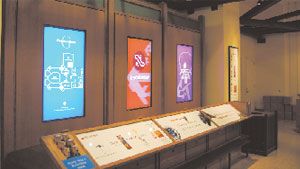
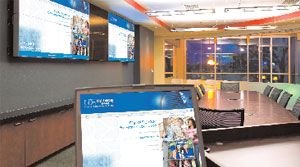
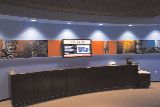
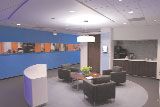
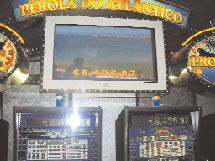
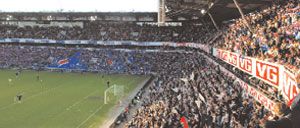
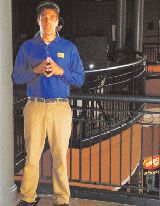
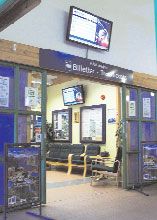
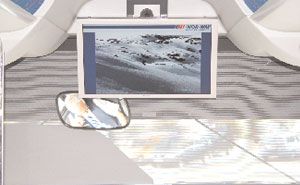
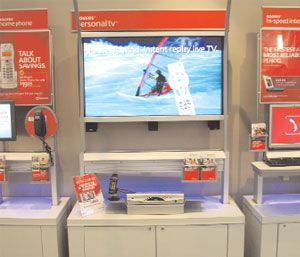
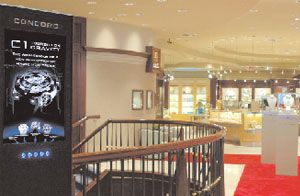
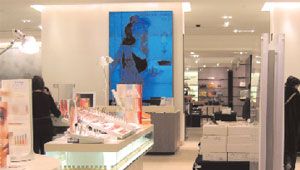
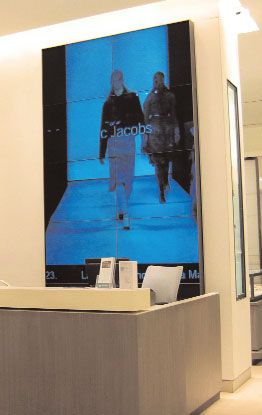
- Develop narrow casting circuits with hundred of points of emission of personalized multimedia advertising contents.
- Segment all of the contents based on time frame, geographical, market and qualitative data; and based on the point of sales objectives.
- Develop, integrate, manage and transmit all multimedia contents through user-friendly content management solution (internal or external).
- Lowers advertising expenditures at the POS (point of sale) and ensures quality of the marketing contents and manage the effectiveness of the publicity at the point of sales.
- Superior advertising impact at POS (brand awareness / purchase ratio).
- Ability to sell time / space to third parties (potential revenue stream).
- Portrays high tech modern image of the brand.
- Potential training tool for POS staff (during downtime).
Special features include Peer-to-Peer, web-based Digital Signage Marketplace, RFID functionalities (offers new possibilities for loyalty programs and program information totems), smart contents, dynamic template, real-time information, statistics, full management via browser, mobile applications, web video posting solution, user rights & management web system, screen saver option, plug-and-play (a demo can be running any where in the world in a matter of minutes), and artificial intelligence - playlists are based on business rules (man or woman) with an integrated AI software.
Because of all these functions and more the Admira Suite has won bids in FNAC, Media Markt, Carrefour, Ticket Master, Klisseran, Tamoil, Incasol, Metro of Barcelona, Caja Madrid, etc. It has had to compete against software of numerous countries. In a way, the most "well known" solutions are American. This solution has been adopted by numerous clients due to its advanced functionalities, R&D innovation, ease of implementation and use. According to the Digital Signage director of Media Markt Spain, Admira suite is the best solution after having evaluated more than 20 solutions. It is also integrated with Media Markts intranet and inventory systems.
Admira; www.admiradn.com; +34 (93) 415-0930.
Flat Panel Display
TRED EMD2 HybridSign
As of August 2008 Tred has developed and launched with SemaSys the company's new EMD2 Green-tech Display Product. The launch is aimed toward indoor retail price changer networks including wireless communication and price changer TredNet software. This is achieved by means of a completely new display technology (Tred's EMD2 tech).
The intended user is someone looking for true Green-tech - offering less than two-percent the power consumption of comparable LED displays. Communication is 100-percent wireless -- with self-contained power (AA batteries), lightweight and thin -- making it 100-percent portable just like a trad. printed sign. This allows retailers to install digital signs that are green with low-cost install and pleasing to the eye (non-light emitting). It also retailers to change prices on the fly and affords 100-percent price compliance.
There are no competitors to this product from a price or performance standpoint. The closest would an EPaper display product, but those are more expensive and are difficult to use outdoors. EPaper displays also do not have a high level of reflectivity (only about 40-percent) whereas Tred's EMD2 display products are 75-percent reflective. There are also no serious players marketing such a solution.
Tred Displays; www.treddisplays.com; 505-856-2488.
Screen Materials
AccelerOptics XLV-100 Digital Display
As of November 2007, AccelerOptics manufactures the XLV-100 Digital Display, which is designed for large-area digital signage applications, such as malls, airports, sports & entertainment venues and gaming. The XLV-100 digital displays are engineered to deliver superior performance to an electronic device in high-ambient lighting conditions using front projection technology. The multi-patented micro-structured surface rejects ambient light while capturing and redistributing the projected light to a defined viewing area in order to create a digital image with ultra-high optical gains, no glare and better contrast.
There is universal demand for large, high-resolution displays that perform well in brightly-lit public spaces, while delivering bigger, brighter, bolder messages. Until the XLV-100, there have been no 100-inch display options available at an economical price. AccelerOptics has developed an alternative that enables projection where it has never been a consideration before. This solution for large-area digital signage is a fraction of the cost of plasma and LED options. This display is lightweight and easy to install and is more durable than any electronic device.
Because the XLV-100 is a fraction of the cost of high-end electronic devices, the overall system costs are much lower. In addition, there are many other major advantages that the XLV-100 has over competing technologies. Size: The XLV-100
AccelerOptics XLV-100 measures 100-inches diagonally vs. the most common electronic displays that are only 40 -- 60 inches. Weight: The XLV-100 weighs only 65 pounds vs. a 100-inch plasma that weighs up to 500 pounds. Other advantages include ambient light rejection with no surface glare, extreme durability, no heat generation, and lower power consumption. In addition, typical projection screens feature a "sweet spot," where the image brightness and contrast ratio is at its optimum straight on and then as the viewer walks off axis the image diminishes. The XLV-100 maintains peak gains, contrast and ambient light rejection throughout the entire viewer volume so that the image remains bright and vivid even as the viewer moves off-center.
AccelerOptics; www.acceleroptics.com, www.xlavision.com; 417-237-0905.
Media Player
NEC MPD-SBC-16
Made available in June 2008, the NEC MPD-SBC-16 provides for a seamless internal PC solution that offers robust flexibility and performance needed to process digital signage content. It eliminates the need for an external PC, providing for clean, hidden integration while reducing the bill of materials needed for installation, and eliminating the hassle of hiding hardware equipment. Service can be performed while the display is still mounted, simplifying installation and reducing maintenance.
The NEC MPD-SBC-16 boasts a 1.66 GHz Core Duo processor, 80 GB HDD and 2 GB RAM. One also has the ability to drive a second display with discrete imaging via a DVI-I output. Microsoft Windows XP Pro is included as the standard operating system. Both landscape and portrait orientations are supported, and the RS-232 port enables for firmware updates and system monitoring of the PC and display, ensuring 100-percent uptime of a digital signage network. The MPD-SBC-16 is compatible with the expansion slots found on most NEC large-format LCD displays (40- to 65-inch) and features a three-year warranty, matching that of NEC's displays. These benefits make NEC's single board computer an ideal digital signage solution in markets such as transportation, public information, corporate, retail and rental staging.
The
The NEC MPDSBC-16 features the Intel 945GM Express Chipset for rendering exceptional 3D graphics performance and resolutions up to 1920_1080. In addition, the ExpressCard NEC MPD-SBC-16 features the Intel 945GM Express Chipset for rendering exceptional 3D graphics performance and resolutions up to 1920_1080. In addition, the ExpressCard Slot allows for use of WLAN, UMTS and DVB-T. A unit from LG, for example, features no OS and has limited Video RAM of 128 versus NEC's 224 VRAM. The Panasonic unit features an external fan and has limited processing power (Celeron vs. Core Duo). These among other factors make the MPD-SBC-16 a successful introduction.
NEC; www.necdisplay.com; 630-467-3000, 866-632-6673.
Connectivity/Peripheral
Minicom DS Vision 3000
Installed Between November 2007 and February 2008 in Landmark Theatres to help reduce operating expenses, the Minicom DS Vision 3000 helps deliver high-definition video and stereo audio from a single player, over CAT5/6/7 cable, to multiple plasma/LCD screens located up to 600m/2000ft away. The most comprehensive system of its kind, DS Vision combines the longest range available with full bi-directional control and the industries only GUI based management program.
This is the only system on the market to include fully bi-directional RS-232 communication, enabling you to not only send a command, but also query the screen and get a response. It eliminates the need to walk from screen to screen. With DS Vision 3000, you can remotely monitor screen operation time, view screen status, adjust volume and brightness and turn screens on/off all from your own console. Monitoring screen time helps you to minimize screen wear and tear allowing you to double or even triple the life of your digital signage network.
This system reduces equipment costs, as it multiplies the number of screens without adding additional players to the network. It also allows lower software and content licensing. It eliminates unnecessary hardware. It also simplifies maintenance by servicing a single player instead of a player per-screen. All the above, with a cost less expensive and a warranty longer than competitors, such as Magenta's Multiview, Adder's AV 200 and Scion Tech's Pro 9000.
